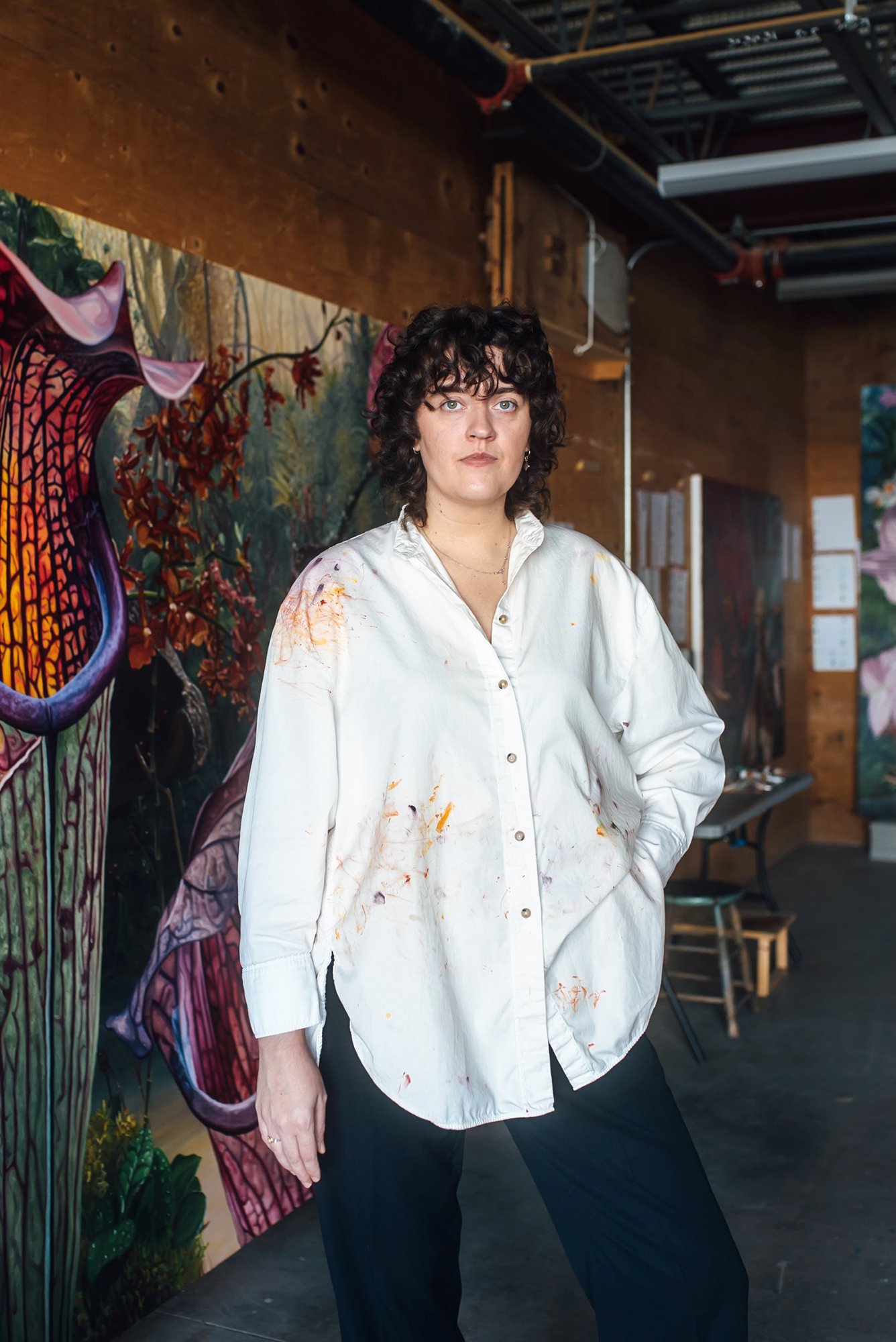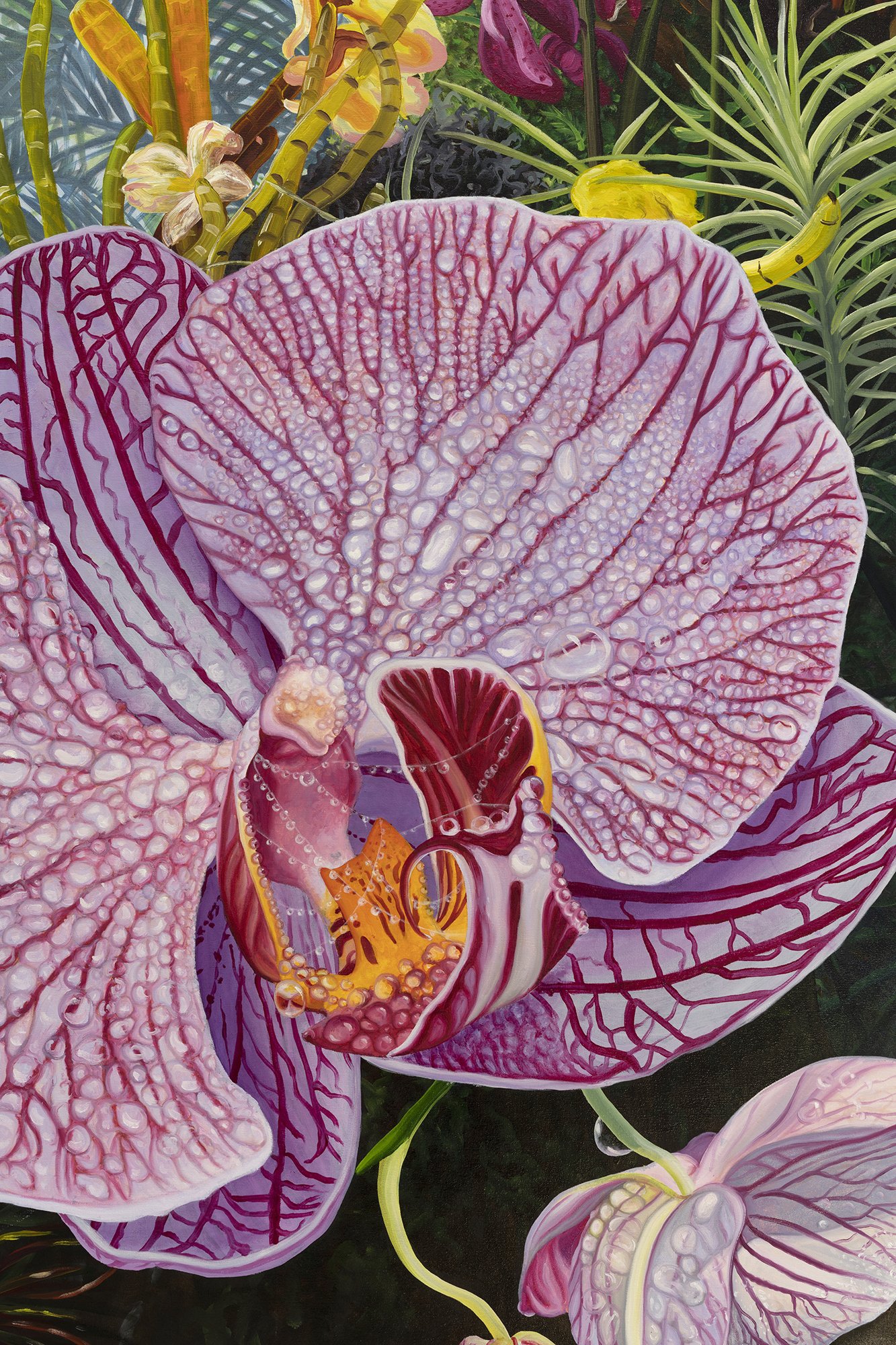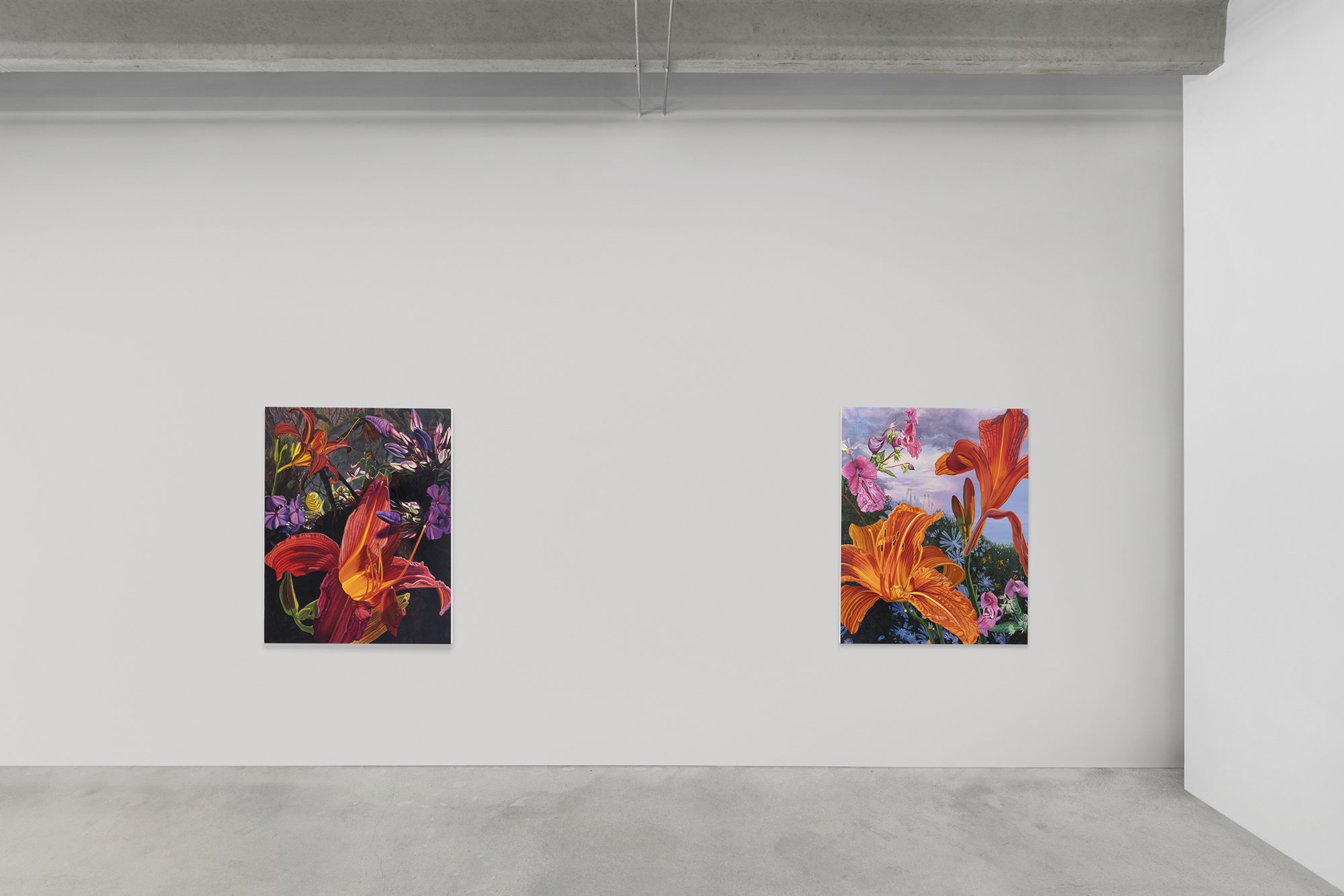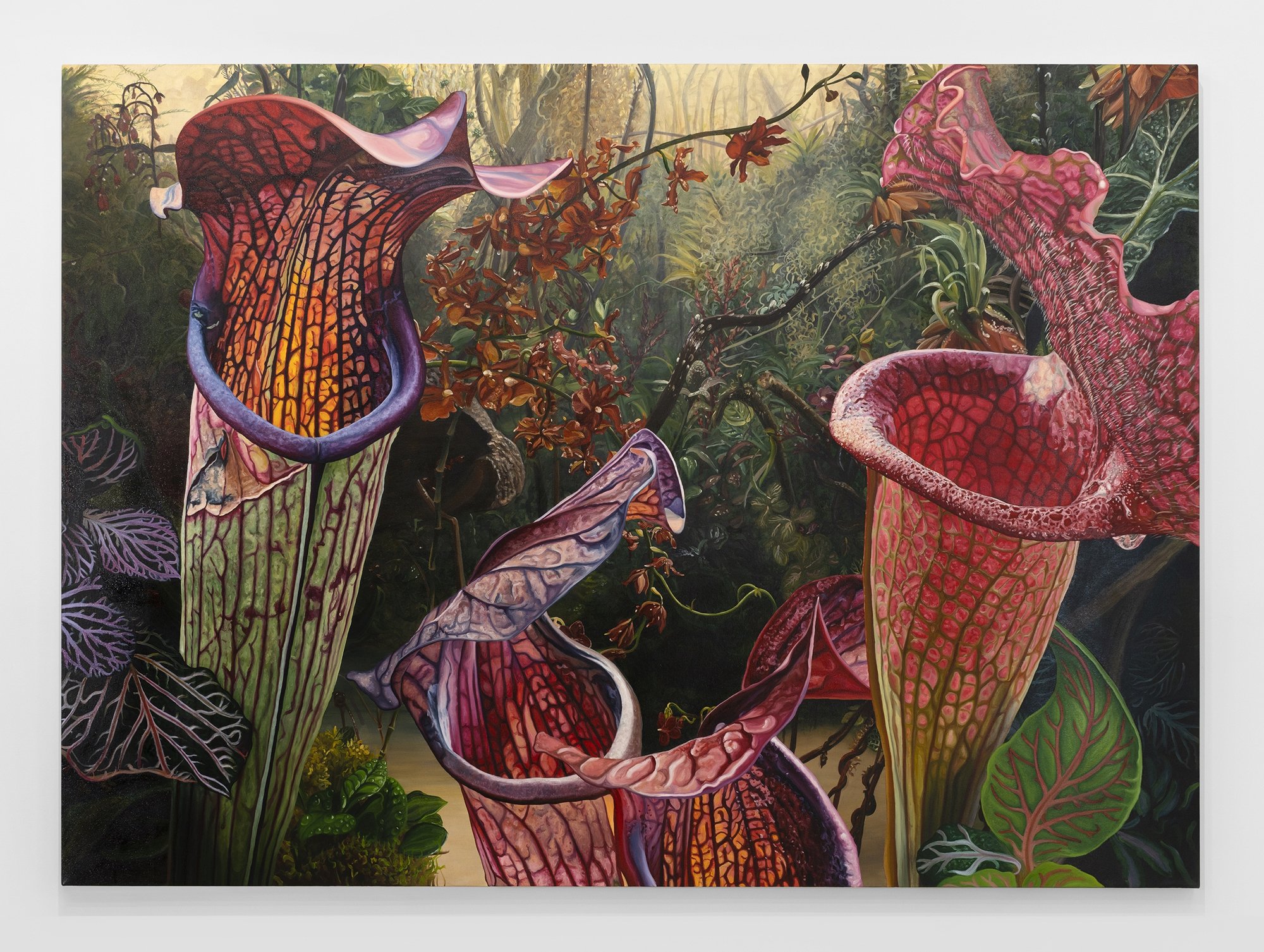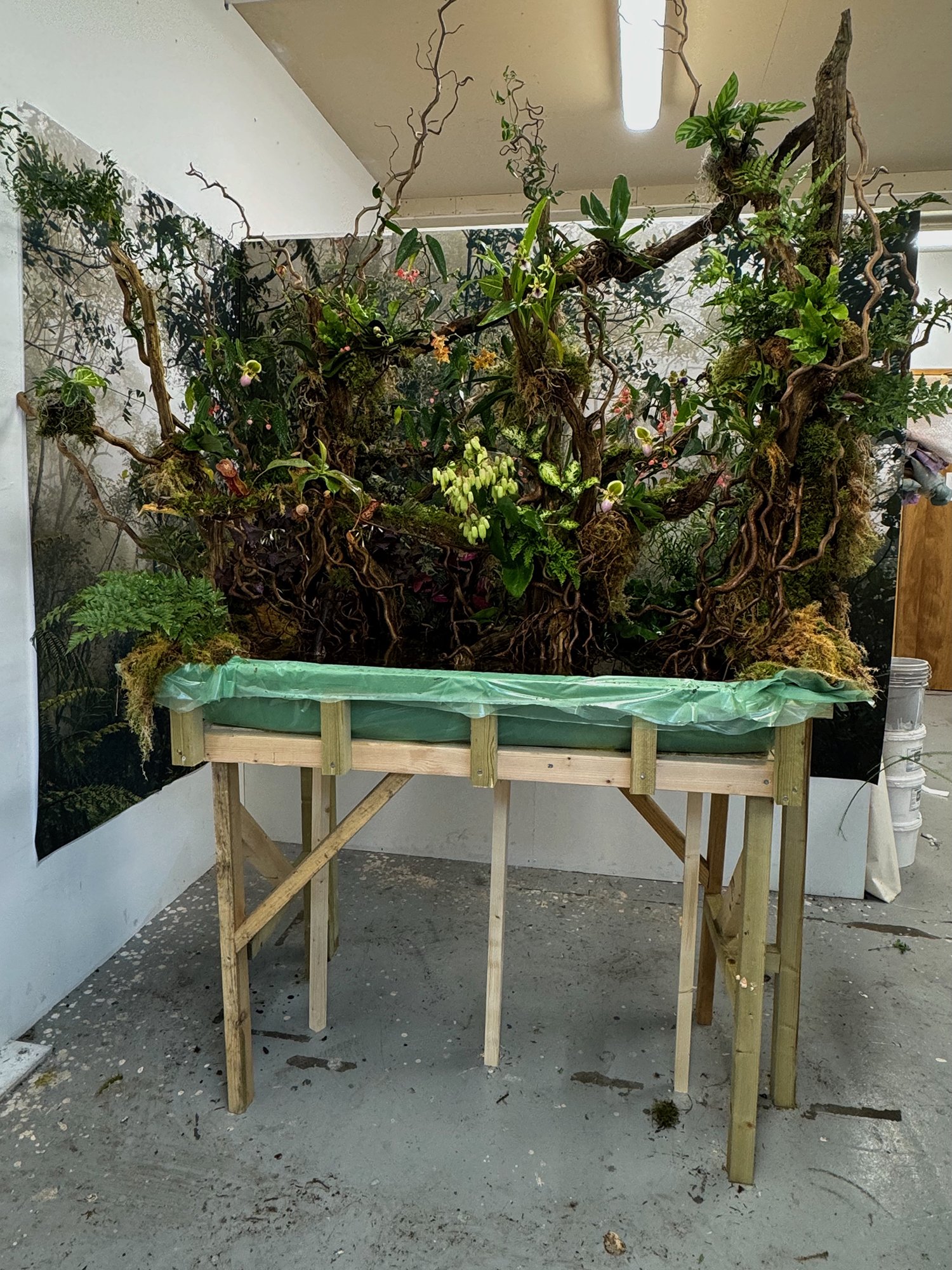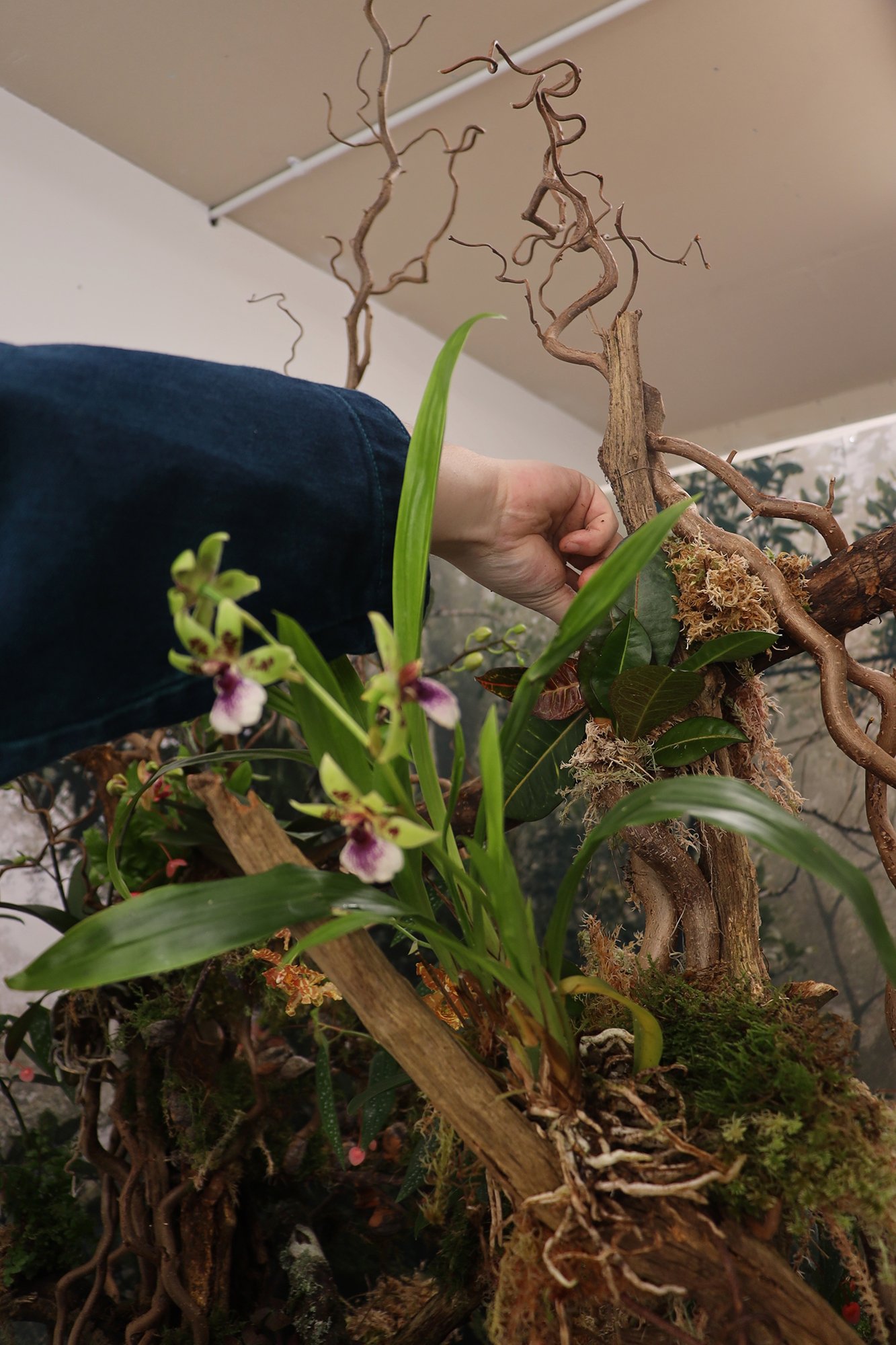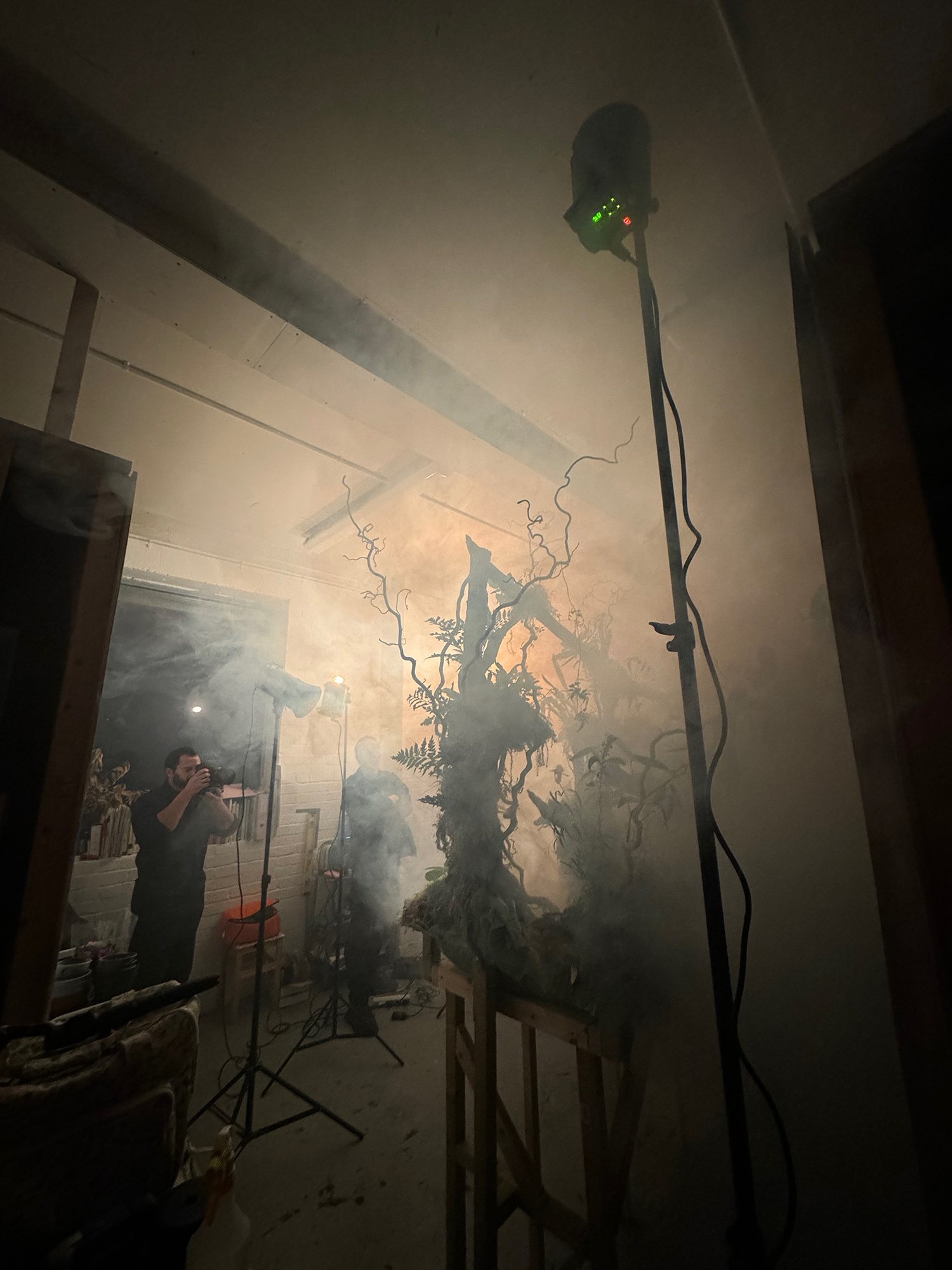Kate Bickmore
Installation shot of 'After Rainfall' at Andrew Reed Gallery
After Rainfall
Artist Kate Bickmore is based between London, UK and Rockland, Maine and creates colorful, immersive paintings of large-scale flowers. Her work is inspired by her experiences of nature and “awe” as a highly sensitive queer woman. Kate explores nature in search of the sublime. She travels around the world documenting her intimate observations through writing and photography, as well as working with florist Samuel Thomas to create floral dioramas in her studio that are lit and photographed for reference. Learn more about her perspective and process.
Studio portrait by Rachel Darke
Detail of Kaleidoscopic Fluttering Through Misty Crowns - oil on canvas, 96 x 66 inches (244 x 168 cm)
Could you tell us about yourself?
Of course! I’m a queer, woman artist and am based between London, UK and Rockland, Maine. I’m originally from the Hudson Valley, NY.
Since when have you been drawing and when did you start painting?
I’ve been drawing ever since I can remember! My grandma loves to tell a story of how when I was 3 or 4 I would walk around the garden drawing all the flowers and she would tell me what they were and write the names underneath. I learned how to paint first with watercolors in high school, and then started oil painting in college.
On the Shoreline Before the Setting Sun - oil on canvas, 60 x 48 inches (152 x 122 cm)
Installation shot of 'After Rainfall' at Andrew Reed Gallery
What’s the story and process that lies behind your paintings?
I make colorful, immersive paintings of large-scale flowers that are inspired by my experiences of nature and ‘awe’ as a highly sensitive queer woman. My hope is to introduce a new queer, feminine perspective to how we traditionally view nature. Instead of being seen as something passive, I want people to experience plants and flowers as having power, agency, limitless physicality, queer individuality, and cosmic connectivity.
All the flowers I paint are ones I’ve seen either in my surroundings or from travels. More recently I’ve been traveling with the objective of seeing specific plants, whether that’s the ghost orchid in the Fakahatchee Swamp or the Rafflesia in the cloud forests of Borneo. Sometimes I get lucky, and sometimes I don’t, but I always find something that inspires me.
I also work with a florist, Samuel Thomas, to create living floral dioramas that are inspired by these landscapes. The diorama is lit and photographed, and I’ll collage the images with ones from my travels as a basis for the compositions of my paintings. I’ll also usually make watercolor studies — a more immersive botanical illustration — in addition to the oil paintings.
Do you mostly use oil painting? What’s your favorite technique and why?
I find oil painting to be the most effective in capturing an experience of “awe” because it’s the only medium that can create both a 2D illusionistic space that we perceive as 3D, and physical space that is 3D. This allows me to create landscapes that exist behind the canvas as well as build up paint on the surface to create a fleshy texture for the plants. With oils I can also paint many layers which helps to make the flowers recede into a vast, otherworldly space, as well as emerge out of the depths of the canvas into the physical space in front of the viewer.
Installation shot of 'After Rainfall' at Andrew Reed Gallery
lluminated Vessels of a Heavy Heart - oil on canvas, 78 x 108 inches (198 x 274 cm)
Do you prefer working on large-scale canvas? If so could you explain why?
I love working on a large scale. It allows me to get into the detail and body of the flowers, because as I’m working on them, I’m so close — almost inside the plants — that I can’t see the edges of the canvas. It feels like a boundary-less space. I also think there something as a viewer that happens when you walk up to a painting of a flower that’s bigger than you — you feel small in comparison, in the same way one might feel looking into a forest at night or over a mountain vista.
How much time do you usually spend on one painting?
This is such a hard question to answer as I work on multiple paintings at once. I’d say a large painting is usually in the studio somewhere between 4-6 months, but I’ll complete a few during that time.
How and why did you pick Flowers and women as your main source of inspiration?
I’ve always been interested in how my body relates to nature, especially as a woman. Ever since I can remember, nature was a place I could go where I didn’t have to worry about the (male) gaze and could fully be myself. As I got older, I noticed that most paintings of women in nature depicted them as these passive, beautiful objects for consumption, (think ‘Ophelia’ by John Everett Millais) which isn’t at all how I experience nature. Flowers are also often used in poetry as metaphors for women because of their perceived purity and ephemeral beauty, but to me they’re so much more than just that. Flowers and plants are wildly complex, constantly evolving and adapting, often have multiple sex parts and sexually reproduce in the most extraordinary ways. When I look at a flower I see the universe, and all the amazing things that had to happen for me and the flower to exist.
Silhouettes Caught by Crimson Heat - oil on canvas, 54 x 64 inches (137 x 163 cm)
There is a kind of Georgia O’Keefe vibe in your work, known for her close-up flower paintings. Would you say she has been a source of inspiration?
Absolutely. I couldn’t do what I do without her. I got some backlash in graduate school because some people within the art world perceive “flower painting” as something provincial, but anyone who looks at a Georgia O’Keeffe painting will see it’s not just a painting of a flower — it’s a new way of viewing the world around us.
What do you find essential when looking at a painting?
To look at it in person and not just online! I think a painting is most successful when it grips you — where you experience something that makes you want to look longer or learn more. If a painting does that for you then you’ve been given a tremendous gift.
If we deep into the world of Nature, what inspires you the most?
This is constantly changing for me, but right now I’m inspired by nature’s ability to create an experience of ‘awe’. Dacher Keltner describes awe as “the feeling of being in the presence of something vast that transcends your understanding of the world.” I think this is a wildly important experience that deeply connects us to nature.
What’s your favorite flower and why?
An impossible question! This is also constantly changing for me. It depends on the season, where I am, what I’m going through. Recently, I’ve been seduced by orchids, specifically slipper orchids, as well as the majestic Rafflesia flower (which technically isn’t a flower, but a parasitic plant).
Could you tell us about your latest collaboration with the florist Samuel Thomas?
Samuel Thomas is a brilliant, queer florist based in London, and a dear friend of mine. We recently collaborated on a floral diorama inspired by my recent trip to Borneo, which his partner Lucien Pinchon photographed. The diorama is made up of salvaged wood, moss, and many different plants. I’ve been using the photos to create collages on Procreate, which will be the basis for my compositions for my upcoming show in NYC.
When and how did the idea of this installation came up? Could you explain what is the Diorama?
To be honest, I can’t remember exactly when the idea for the floral installation emerged. I did a Dutch Flower Master Floral workshop at the London Flower School, and think I realized after that I’m terrible at floristry but loved the idea of working from elaborate floral still lifes to create compositions for my paintings. I met Sam through a mutual friend, and we built our first living floral diorama in the fall of 2021. This is our 4th one and they keep getting better and better!
I would describe the living diorama as a cross between a floral still life and a botanical Natural History museum-esq diorama. They’re quite big — much bigger than a traditional floral still life — and composed of almost all organic material. They also feel like miniature landscapes, like a garden for a faerie.
Anything you would like to add about this project?
It’s been so thrilling as a painter to cross over into different worlds, whether that’s floristry, botany, conservation, etc. Although I only use the images as references for the paintings, I think they’re so wonderful and dreamy in their own right (thank you Lucien!). I’m so happy to be able to share them, and excited to see how our collaboration continues to develop.
Floral Diorama by Samuel Thomas- Picture Lucien Pinchon
More about Kate Bickmore art on katebickmore.com - @katebickmore
Floral artist Samuel Thomas - @samueljosephthomas
Photographers Lucien Pinchon - @lucien_pinchon & Rachel Darke @racheldarke


